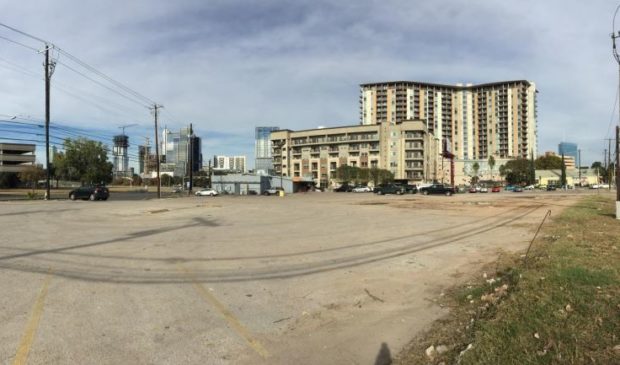Environmental Commission recommends Hooters PUD
Thursday, January 18, 2018 by
Jessi Devenyns Unable to wait for the codification of the new South Central Waterfront Vision Framework Plan and its associated environmental standards, eager builders came to the Environmental Commission on Jan. 3 in pursuit of a planned unit development on the site of Austin’s only Hooters restaurant.
Ronald A. Nelson and Molly Belle Properties are requesting a zoning change from General Commercial Services (CS) to Planned Unit Development (PUD) for the 1.45-acre property at 425 W. Riverside Drive. The zoning change will accommodate their intended 195-foot building. Under the current commercial zoning, the maximum height the building can be is 60 feet.
“Because we’re a little early (for the South Central Waterfront Plan), we’re asking for a PUD, which is actually a benefit to the city,” said Richard Suttle, a development lawyer who spoke on behalf of the applicant to explain the reasoning behind the request.
Planned unit developments are intended for large or complex developments that are unified as a single continuous project. This zoning designation allows multi-use projects and greater design flexibility within its boundaries by requiring that developers construct a superior development to that which would occur using conventional zoning regulations.
For 425 W. Riverside Drive, this means environmental enhancements to the currently barren lot as well as the construction of 270,525 square feet of office space, 21,045 square feet of retail and 10 residential units.
As part of the PUD, the proposed project offers a number of community benefits that would not otherwise be part of the existing zoning. These benefits include ground-floor retail, increased number and variety of trees, 4,300 square feet of landscaping including green roofs, enhanced green water quality controls, the extension of the city’s reclaimed water system into the South Central Waterfront district, and the water quality treatment for a portion of Barton Springs Road.
Becoming environmentally superior to the current state, however, is not a high bar. “The site is nearly 100 percent impervious cover,” said Andrea Bates, who is the environmental program coordinator for the Watershed Protection Department. Furthermore, there is no impervious cover mitigation on the property. According to her, the closest thing to landscaping is the one tree on the property, which happens to be an invasive species.
Despite this, Commissioner Linda Guerrero noted, “I know that the neighborhood association isn’t keen on this PUD.”
According to Commissioner Pam Thompson, the building’s proposed height is behind the neighborhood association’s dislike of the project. So that the neighborhood doesn’t have to gaze at a “box,” the developers have fashioned a compromise that includes the installation of tiered green roofs.
Chair Maria Perales said that if the commission were to consider this request outside of the context of the South Central Waterfront Initiative and simply as a PUD variance request, it would be “pretty straightforward.” However, she said, “If we’re going to consider how this fits into the bigger scheme, I don’t think we can do that tonight.”
Commissioner Kathleen Coyne explained, “The only reason there is a PUD being brought up is because (the South Central Waterfront Initiative) hasn’t been codified yet.”
The South Central Waterfront Vision Framework Plan was adopted by City Council in 2016 and was established to expand the open space and increase pedestrian access to 118 acres south of the river at Congress Avenue as well as increase affordable housing units to 20 percent of the total in the new housing developments.
Currently, the regulatory plan is developing under the watchful eye of the South Central Waterfront Advisory Board.
Bates explained that in terms of water quality controls, this particular PUD was instrumental. “This project played a very key role in refining that (South Central Waterfront) proposal,” she said. Indeed, no commissioner argued against the environmental superiority of this project. Despite their reluctance to encourage PUDs in this district, the commissioners voted unanimously to approve a recommendation for the rezoning of this development site.
Commissioner Hank Smith said, “If we’re going to have a project to kick it all off, this is a good project.”
This article has been updated to clarify the references to the South Central Waterfront Plan. The Austin Monitor’s work is made possible by donations from the community. Though our reporting covers donors from time to time, we are careful to keep business and editorial efforts separate while maintaining transparency. A complete list of donors is available here, and our code of ethics is explained here.
You're a community leader
And we’re honored you look to us for serious, in-depth news. You know a strong community needs local and dedicated watchdog reporting. We’re here for you and that won’t change. Now will you take the powerful next step and support our nonprofit news organization?






